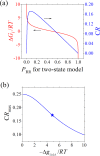A comprehensive ensemble model for comparing the allosteric effect of ordered and disordered proteins
- PMID: 30507941
- PMCID: PMC6292653
- DOI: 10.1371/journal.pcbi.1006393
A comprehensive ensemble model for comparing the allosteric effect of ordered and disordered proteins
Abstract
Intrinsically disordered proteins/regions (IDPs/IDRs) are prevalent in allosteric regulation. It was previously thought that intrinsic disorder is favorable for maximizing the allosteric coupling. Here, we propose a comprehensive ensemble model to compare the roles of both order-order transition and disorder-order transition in allosteric effect. It is revealed that the MWC pathway (order-order transition) has a higher probability than the EAM pathway (disorder-order transition) in allostery, suggesting a complicated role of IDPs/IDRs in regulatory proteins. In addition, an analytic formula for the maximal allosteric coupling response is obtained, which shows that too stable or too unstable state is unfavorable to endow allostery, and is thus helpful for rational design of allosteric drugs.
Conflict of interest statement
The authors have declared that no competing interests exist.
Figures










Similar articles
-
Assessing Allostery in Intrinsically Disordered Proteins With Ensemble Allosteric Model.Methods Enzymol. 2018;611:531-557. doi: 10.1016/bs.mie.2018.09.004. Epub 2018 Oct 24. Methods Enzymol. 2018. PMID: 30471699
-
Expanding the Paradigm: Intrinsically Disordered Proteins and Allosteric Regulation.J Mol Biol. 2018 Aug 3;430(16):2309-2320. doi: 10.1016/j.jmb.2018.04.003. Epub 2018 Apr 7. J Mol Biol. 2018. PMID: 29634920 Free PMC article. Review.
-
Configurational Entropy of Folded Proteins and Its Importance for Intrinsically Disordered Proteins.Int J Mol Sci. 2021 Mar 26;22(7):3420. doi: 10.3390/ijms22073420. Int J Mol Sci. 2021. PMID: 33810353 Free PMC article.
-
Quantifying Protein Disorder through Measures of Excess Conformational Entropy.J Phys Chem B. 2016 May 19;120(19):4341-50. doi: 10.1021/acs.jpcb.6b00658. Epub 2016 May 4. J Phys Chem B. 2016. PMID: 27111521
-
Allosteric Modulation of Intrinsically Disordered Proteins.Adv Exp Med Biol. 2019;1163:335-357. doi: 10.1007/978-981-13-8719-7_14. Adv Exp Med Biol. 2019. PMID: 31707710 Review.
Cited by
-
Entropy and Information within Intrinsically Disordered Protein Regions.Entropy (Basel). 2019 Jul 6;21(7):662. doi: 10.3390/e21070662. Entropy (Basel). 2019. PMID: 33267376 Free PMC article.
-
Allostery: Allosteric Cancer Drivers and Innovative Allosteric Drugs.J Mol Biol. 2022 Sep 15;434(17):167569. doi: 10.1016/j.jmb.2022.167569. Epub 2022 Apr 1. J Mol Biol. 2022. PMID: 35378118 Free PMC article. Review.
-
Protein conformational ensembles in function: roles and mechanisms.RSC Chem Biol. 2023 Sep 5;4(11):850-864. doi: 10.1039/d3cb00114h. eCollection 2023 Nov 1. RSC Chem Biol. 2023. PMID: 37920394 Free PMC article. Review.
-
Intrinsically disordered proteins: Ensembles at the limits of Anfinsen's dogma.Biophys Rev (Melville). 2022 Mar 17;3(1):011306. doi: 10.1063/5.0080512. eCollection 2022 Mar. Biophys Rev (Melville). 2022. PMID: 38505224 Free PMC article. Review.
-
Leaderless secretory proteins of the neurodegenerative diseases via TNTs: a structure-function perspective.Front Mol Neurosci. 2023 Jun 15;16:983108. doi: 10.3389/fnmol.2023.983108. eCollection 2023. Front Mol Neurosci. 2023. PMID: 37396786 Free PMC article. Review.
References
-
- Fenton AW (2008) Allostery: an illustrated definition for the 'second secret of life'. Trends In Biochemical Sciences 33: 420–425. 10.1016/j.tibs.2008.05.009 - DOI - PMC - PubMed
-
- Monod J, Changeux JP, Jacob F (1963) Allosteric proteins and cellular control systems. Journal Of Molecular Biology 6: 306–329. - PubMed
-
- Monod J, Wyman J, Changeux JP (1965) On nature of allosteric transitions—a plausible model. Journal Of Molecular Biology 12: 88–118. - PubMed
-
- Koshland DE, Nemethy G, Filmer D (1966) Comparison of experimental binding data and theoretical models in proteins containing subunits. Biochemistry 5: 365–385. - PubMed
-
- Eaton WA, Henry ER, Hofrichter J, Mozzarelli A (1999) Is cooperative oxygen binding by hemoglobin really understood? Nature Structural Biology 6: 351–358. 10.1038/7586 - DOI - PubMed
Publication types
MeSH terms
Substances
LinkOut - more resources
Full Text Sources

